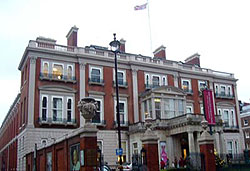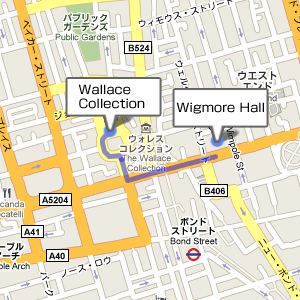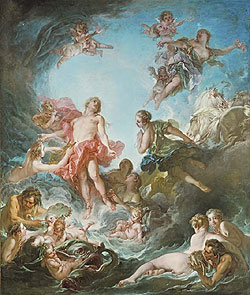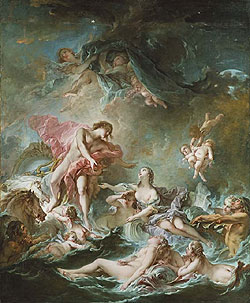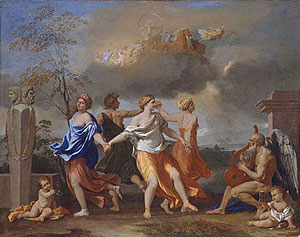English
|
Wigmore Hall's Education Programme No.3
Music and Paintings Wigmore Hall's educational programme for children includes various kinds of collaboration with other genres of art. Working with fine arts is one of the most popular forms of collaboration. This time, I will explore the Family Day event called 'Myths and Legends', targeted at children over 6 years old and their families. |
Title: Family Day 'Myths and Legends'
Date: Saturday 21th November 2009, 10:15-16:00
<PM> Wigmore Hall
Target: Over 6 years old and their parents
Artists: Bridget Crowley(Children's author) / Dominic Harlan(Pianist)
Fee: £8 Children, £10 Adults
The Family Day in November was held in collaboration with the Wallace Collection in London. It is a gallery located in a quiet square just north of Wigmore Hall. The building, Hertford House, was originally built in the 18th century for an aristocratic family, and used as a residence, for social parties and, at times, as an embassy. The collection, which includes French and Dutch paintings, furniture, sculpture, arms and armour, was acquired between the late 18th and the 19th centuries, by four Marquesses of Hertford and Sir Richard Wallace (1818-1890). It was bequeathed to the British nation by Lady Wallace, and the Wallace Collection opened to the public as an admission-free national museum on 22 June 1900.
The Wallace Collection itself hosts various kinds of educational programme, such as gallery talks, art classes and workshops for families. Although Wigmore Hall also collaborates with other museums, the partnership with the Wallace Collection is stronger than the others, and they work together several times per year. This is not only because of the quality of the collection but also the geographical closeness. Elizabeth McCall, senior producer of Wigmore Hall Learning, said, 'When two venues are far away and we have to have two workshops on different days, children might not attend both of them, and even if they do, they might not remember clearly what they had seen a week before. With the Wallace Collection, the participants can explore both venues on the same day, so we can do the workshop based on the shared, fresh memory, and in that way, it works as a true collaboration'.
She also told me that, 'There are two aims when collaborating with fine arts. The first is to enhance the source of inspiration of children. Inspiration plays an important role both in music and fine art. The second is to double our customers. The hall has an audience who like music and the museum has visitors who like fine art. What we expect is to enrich our customers by connecting them'.
The children and their parents started the day at 10:15 in the morning and visited the Wallace Collection to appreciate art. As in many other museums in Europe, the valuable collection was right in front of their eyes, not behind ropes or glass. When entering the rooms filled with antique furniture, paintings and sculptures, climbing the Grand Staircase, and walking in the Great Gallery, which used to host many banquets and balls, they can appreciate the collection as if they had been invited into the home of an aristocrat.
The guide for the art part of the workshop was Bridget, who also works as a children's author. The children and their parents viewed the collection guided by her. Three paintings were featured. Two of them were hanging on the wall of the Grand Staircase; 'The Rising of the Sun' (1753) and 'The Setting of the Sun' (1752) by the French artist François Boucher (1703-1770). They form a pair based on the Greek mythology; 'The Rising of the Sun' depicts the sun god Apollo driving his chariot from the east to bring light to the world, while 'The Setting of the Sun' shows him returning to the goddess of the sea in the west. Apollo, also known as the god of music, appears with a lyre in both paintings. The third painting was 'A Dance to the Music of Time' (c1634-c1636) by Nicolas Poussin (1594-1665), in which we see four gods dancing in a circle and Apollo galloping above them. Those four gods are said to represent the four seasons, or the cycle of a human life.
The participants looked at the paintings and listened to the story hidden behind them. Bridget also asked children a lot of questions about the paintings, such as, 'Why do you think this character has lots of muscle?' and children said, 'Because he is powerful!' Asking questions encouraged the children to look into the paintings. Then they wrote poems based on the inspiration derived from the experience. The mother of one boy told me, 'We came here today because my son was interested in music, without knowing whether he would show an interest in fine art, but he is really enjoying the museum, too. It is good to enjoy both of them'. With a fresh image of the paintings and their own poems, they headed to Wigmore Hall where the rest of the workshop would take place.
The workshop leader in the afternoon was a pianist called Dominic. At first, they did warm-up activities in a circle, in order to prepare their bodies and minds for making music. As it was the Family Day, every child or parent equally participated in the activity. Dominic and the hall staff joined in the workshop in the morning, and those who were in charge of the art part joined in the music part as well.
The participants watched Dominic carefully and copied him: rubbing their hands, covering their faces, and jumping. Saying 'Watch carefully...', Dominic opened his arms wide and brought them together again. The participants tried to clap their hands at exactly the same time as Dominic, sensing his breath and speed. Then they jumped and landed at the same time, shouting 'Ha!' Repeating it made them perfectly in harmony. Next, they played a game called 'Collect!' They collected whatever they were told, such as elbows, shoulders and the back of the knees, by running around the room and touching as many people as possible. After that, the participants were warmed up and standing next to people whom they did not know.
The next activity was related to shopping. They all pretended to be a wining three-year-old boy and his tired mother, using only facial expressions at first, then words and physical movement. The boy said 'Mama, will you buy me a banana!?' The mother replied, angrily, 'Yes, yes, I will buy you a banana!' Dominic led them to sing it to a tune. At last, it became like a musical play.
The pianist, Dominic, hardly used the piano for the first 15 minutes, but led the group using his expressive voice, face and body, enhancing their concentration and imagination, and making them sing a song based on daily life. He was as expressive as if he were an actor as well.
Once they had warmed up, it was time to make music. Dominic collected words and poems from the participants, talking with them during the lunch hour. They were going to make a song which would tell a story about the paintings they had seen in the morning. For the opening, they sang 'Boo doo' sound in harmony. It was a quiet opening, like dawn.
'Who wants to play a solo?' Dominic asked, and three girls came forward. The first word of the lyrics was the name of the main feature, 'Apollo'. He asked them to think about how to sing this name. Hearing the opening chorus, they started to sing, and gradually found their tunes. Following the solo, all of the others joined in. In turn, the next soloists created a melody with the lyric 'Flowing golden locks', singing mellifluously.
When Dominic asked the participants 'Do you remember the sun in the paintings?', they replied 'Yes! It was shining!' Then he started to play shining sounds on the piano, which led to the next movement. The children created melodies along with the sound in turn. He said, 'I need one more word to add to "Handsome". How handsome was Apollo?' Then one of the children said, 'Very!' He said, 'OK, then we will go with "Handsome, very handsome", and emphasize the word "very"'. He took the idea from the participants and added spice to it; 'Make it flow!' 'Keep that tune and make it faster!'
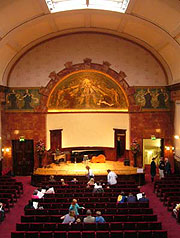
For the latter half of the song, they split into four groups and made music based on the theme of the four seasons, which they saw in 'A Dance to the Music of Time'. Each group, a mixture of children and adults, devised melodies, rhythms and choreography, to express the words they had written, such as, 'shining sunlight', 'whispering', 'snowflakes' and 'rejoicing birth'. The way in which they made music was different in each group; by making sounds using a small xylophone, or reading the lyrics out loud repeatedly and finding the rhythm of them.
To finish the music, they all gathered in the room again. Dominic played jazz-like music on the piano this time, and led them to sing the chorus and each group's part to form a piece. At last, they had a climax scene, with Apollo galloping over the sky, and finished the song archly by singing 'And he's gone!'
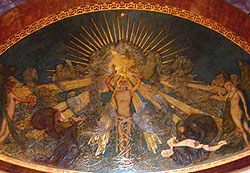 Wigmore Hall has a cupola above the stage with a symbolic painting, and the central figure represents 'the Soul of Music'. 'There's Apollo!', they shouted, 'Let's point to him at the end!', and it became the last pose. The children and adults arranged themselves on the stage and enjoyed the only performance of what they had just created. It must have been a big benefit of the Family Day to have a thrilling experience of expressing their inspiration through lyrics and music, using their own ideas, and performing it on the stage, together with their families.
Wigmore Hall has a cupola above the stage with a symbolic painting, and the central figure represents 'the Soul of Music'. 'There's Apollo!', they shouted, 'Let's point to him at the end!', and it became the last pose. The children and adults arranged themselves on the stage and enjoyed the only performance of what they had just created. It must have been a big benefit of the Family Day to have a thrilling experience of expressing their inspiration through lyrics and music, using their own ideas, and performing it on the stage, together with their families.Report: Chigusa Futako


